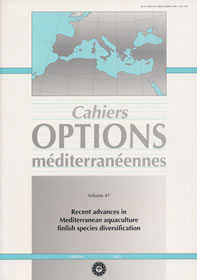| Article précédent | p. 313-321 | Article suivant |
Culture of octopus (Octopus vulgaris, Cuvier): Present knowledge, problems and perspectives
This article reviews the results obtained over a four year research period (1995-1999), on the reproduction, rearing of octopus paralarvae and ongrowing, at the Spanish Institute of Oceanography in Vigo. Optimum conditions for transport, stabling, feeding and induction to spawning are analysed. The biometric characteristics of the strings and eggs, fecundity, embryonic development, hatching and the rearing of 1.5 million of paralarvae are also noted, with a description of the feeding, growth and survival of the newly born paralarvae, using different types of prey. In terms of the results obtained, there is discussion of the best conditions required for ongrowing juveniles, regarding feed, daily ingestion, density of stabling and prior separation according to size and sex, attempting to optimize growth rates and feed conversion. Finally, some of the first experiences on ongrowing at industrial level in Galicia in floating cages are described.
- [ Télécharger ]
- [ Exporter la citation ]
Vous pouvez télécharger la citation au format :
- [ Imprimer ]
- [OMC47]




